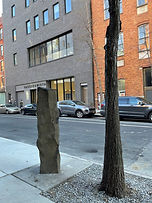

Blog
ECO-ACTIVIST INTERVENTION
1. Joseph Beuys, 7000 Oaks

The 7000 Oaks project didn’t just plant trees—it transformed the urban landscape and sparked a broader environmental movement. Each tree being paired with a basalt stone sourced from a local quarry, symbolized the connection between nature and human industry. Beuys also used 7000 Oaks as a platform to promote his concept of “social sculpture,” where everyone plays a role in shaping society and the environment. The legacy of this work continues to influence ecological art and urban reforestation projects worldwide.

In 1982, German artist Joseph Beuys initiated a groundbreaking ecological art project titled 7000 Oaks as part of Documenta 7 in Kassel. This ambitious work aimed to combat urban degradation through reforestation by planting 7,000 oak trees, each paired with a basalt stone. The project was deeply rooted in community participation, with residents, volunteers, and even Beuys' own son involved in the planting process over five years. Beuys collaborated with local institutions and emphasized the long-term impact of environmental intervention, encouraging citizens to view art not just as an object, but as a tool to create change.

Many cities today face challenges with urban sprawl and loss of green spaces, which negatively impact air quality, biodiversity, and residents’ well-being. Projects like 7000 Oaks show how reintroducing trees into city environments can help counter these effects by improving air and supporting wildlife. Yet, despite these benefits, urban reforestation efforts remain limited and underfunded in many areas. It is essential that communities recognize the long-term value of integrating nature into urban planning to create healthier, more sustainable cities for future generations.
2. Mel Chin, Revival Field

In the years following its launch, Revival Field became a model for collaboration between artists and scientists. The project demonstrated how creative practice could actively participate in solving environmental problems, not just comment on them. Chin and Chaney’s work with hyperaccumulator plants was part of a larger exploration into phytoremediation, a field that was still relatively unknown at the time. As the plants absorbed metals like zinc, cadmium, and nickel from the soil, data collected on-site contributed to real scientific understanding of a very effective solution to overcoming pollution.

In 1990, artist Mel Chin launched Revival Field, an eco-art project on a landfill site near St. Paul, Minnesota. Designed in collaboration with scientist Dr. Rufus Chaney, the piece used hyperaccumulator plants—species capable of extracting heavy metals from contaminated soil—to test the potential of “green remediation.” The living installation was arranged within a geometric garden-like plot, blurring the lines between scientific experiment and environmental sculpture. Revival Field aimed to raise awareness about industrial pollution and propose sustainable, nature-based solutions to toxic waste. The project also questioned who has the power to reclaim damaged environments and how art can directly contribute to ecological restoration.

The installation carried a powerful message about environmental justice and industrial legacy. Revival Field challenged viewers to reconsider the value of “waste” landscapes and who bears the burden of ecological damage. By placing the work in a fenced-off, polluted area, Chin forced the public to confront spaces that are often hidden or ignored. The project continues to be referenced in conversations about sustainable art and site-specific activism. It underscores the idea that art can serve as both witness and solution in the face of environmental crisis.
3. Amy Balkin, Public Smog

Public Smog didn’t just intervene in carbon markets—it reframed the atmosphere itself as a contested cultural and political space. By treating clean air as a shared public good and using legal tools as artistic media, Balkin challenged the prevailing belief that environmental protection can be outsourced to market-based mechanisms. Her attempts to list the atmosphere as a UNESCO World Heritage Site drew attention to the absurdity—and urgency—of protecting something so vast yet vulnerable. Like Beuys’ idea of “social sculpture,” Public Smog invites collective responsibility, asking viewers to consider their own role in shaping climate futures through policy, economics, and activism.

In 2004, American artist Amy Balkin launched a conceptual artwork titled Public Smog, a critical intervention into the politics of climate change and air quality. The project involves the creation of a shifting, invisible “park” in the atmosphere by purchasing and withholding emissions offsets from carbon trading markets, thereby keeping that portion of air unpolluted. Balkin’s work challenges the commodification of the environment and exposes the limitations of market-based climate solutions. Rather than planting trees or altering land, Public Smog operates within legal systems, inviting public engagement with abstract infrastructures that govern global emissions.

Today, as climate crises intensify and global emissions continue to rise, projects like Public Smog remain strikingly relevant. Governments increasingly rely on carbon trading and offset schemes as climate solutions, yet many of these mechanisms fail to reduce emissions meaningfully or equitably. Balkin’s work exposes these shortcomings and calls for deeper structural change—one that prioritizes collective stewardship over corporate compliance. As the atmosphere becomes both a battleground and a commodity, it is crucial for communities to question who gets to control environmental futures.